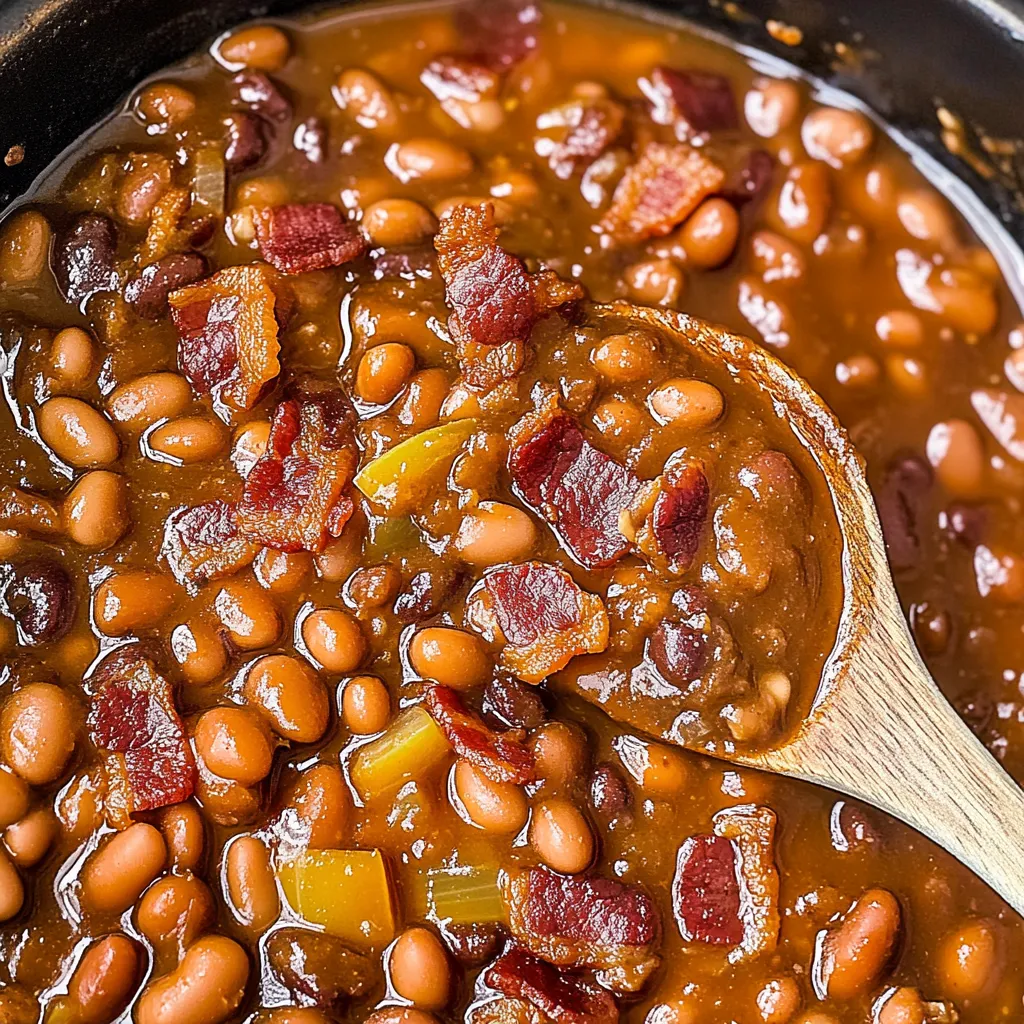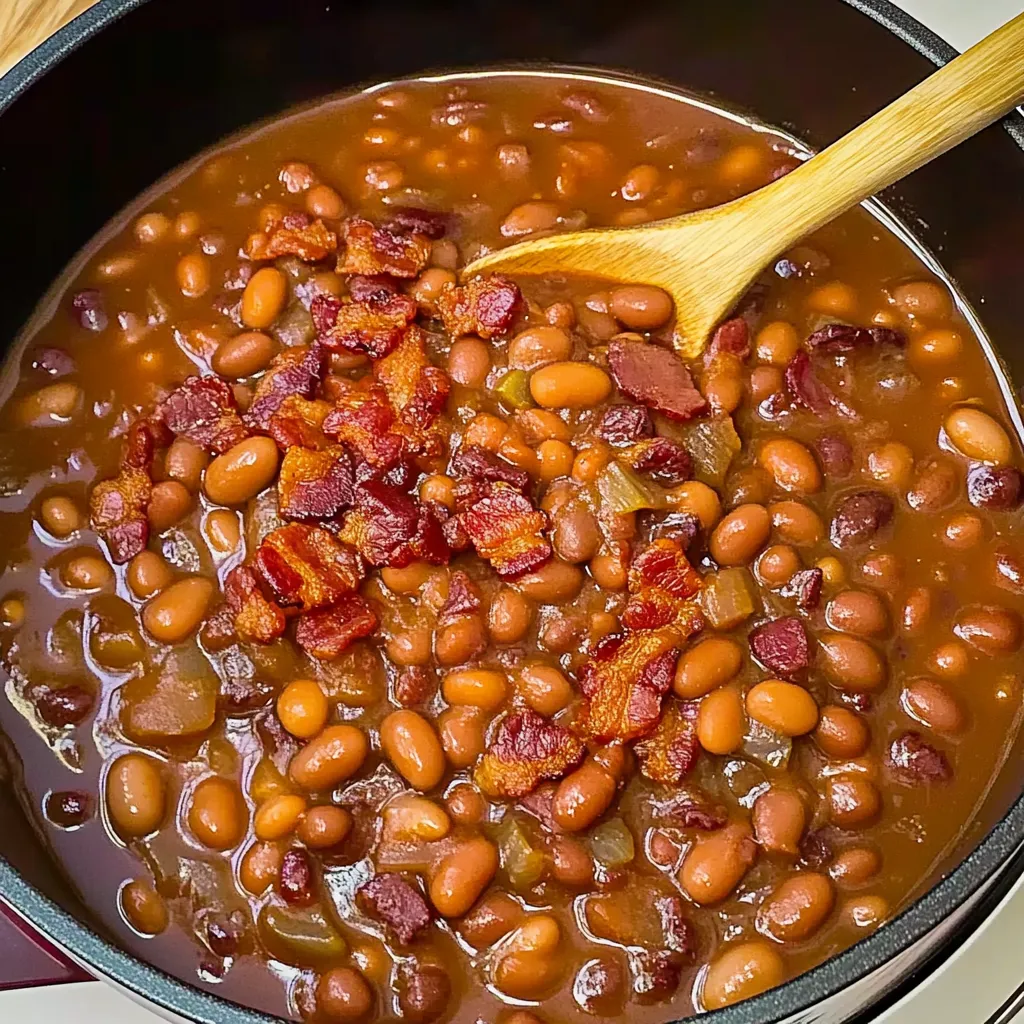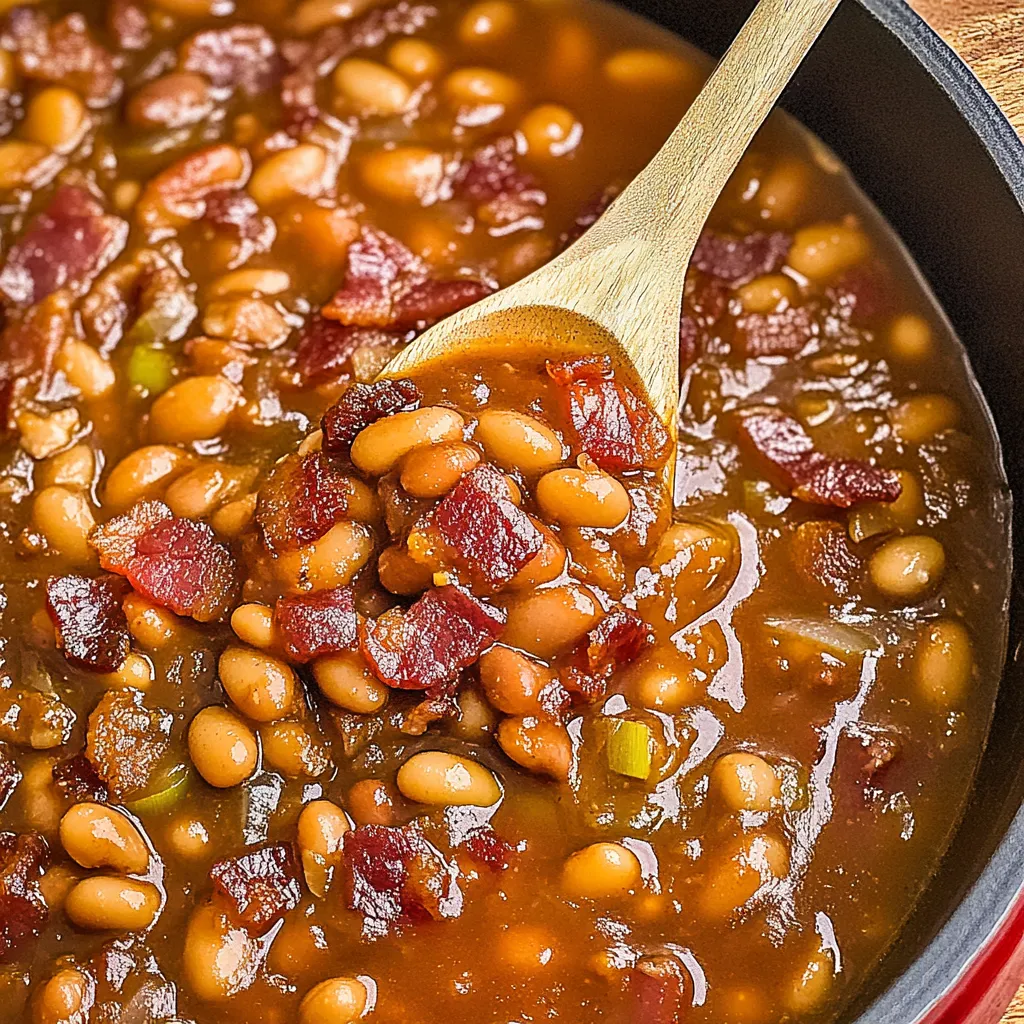 Pin it
Pin it
These bacon baked beans have completely ruined me for any other version because once you've tasted the combination of smoky bacon, brown sugar, bourbon, and molasses creating this rich, glossy sauce, canned beans taste flat and boring in comparison. The depth of flavor that develops from slowly cooking everything together transforms humble beans into something genuinely special that people rave about at every barbecue. I started making these about eight years ago when I was tired of bringing the same old beans to cookouts, and now people specifically ask me to make "those bourbon beans" for every gathering.
My husband used to skip baked beans entirely at barbecues until he tried these, and now he loads up his plate with them and sometimes eats them as a main course. Watching him go back for seconds and thirds tells me everything I need to know about how much better homemade beans are than anything from a can.
Ingredients You'll Need
- Thick-cut bacon: (about 8 ounces, diced into small pieces) - Provides smoky, salty flavor and renders fat that flavors the entire dish; cutting it uniformly ensures even cooking
- Navy beans or pinto beans: (about 2 pounds dried or 4 cans cooked) - Navy beans are traditional and creamy, while pintos work beautifully too; dried beans have better texture but canned saves time
- Sweet onion: (one large, diced) - Adds sweetness and depth when sautéed; yellow or white onions work too
- Bell pepper: (one, any color, diced) - Contributes sweetness and slight vegetal flavor that balances the richness
- Fresh garlic: (several cloves, minced) - Provides aromatic depth that garlic powder can't match
- Bourbon: (about half a cup, any mid-range brand) - Adds complexity and slight sweetness with vanilla and caramel notes; Jim Beam or Wild Turkey work perfectly, no need for expensive bottles
- Ketchup: (about one cup) - Forms the tangy, sweet base of the barbecue sauce coating
- Light brown sugar: (about three-quarters of a cup) - Provides rich sweetness and moisture; dark brown sugar works for stronger molasses flavor
- Molasses: (about a quarter cup) - Adds warm, slightly smoky depth; use medium or dark molasses, not blackstrap which is too bitter
- Yellow mustard: (about two tablespoons) - Brings sharp mustard flavor that cuts through the sweetness
- Apple cider vinegar: (about two tablespoons) - Provides tartness that balances all the sweet elements
- Worcestershire sauce: (about two tablespoons) - Adds savory umami depth and tanginess
Step-by-Step Instructions
- Cook bacon until partially done
- Place a large, heavy-bottomed pot or Dutch oven over medium heat and add your diced bacon pieces, spreading them out so they cook evenly. Cook the bacon for about five to seven minutes, stirring occasionally, until it's partially cooked and has rendered a good amount of fat but isn't yet crispy. You want it about halfway done because it'll continue cooking with the beans, and cooking it completely now would make it too crispy by the end. Leave all that rendered bacon fat in the pot because it's pure flavor that will coat the vegetables and beans.
- Sauté vegetables until softened
- Add your diced onion and bell pepper directly to the pot with the bacon and bacon fat, stirring everything together so the vegetables are coated with that flavorful fat. Cook for about five to seven minutes over medium heat, stirring occasionally, until the onions turn translucent and soft and the peppers lose their raw crunch. Add the minced garlic during the last minute of cooking, stirring constantly so it becomes fragrant without burning. The vegetables should be completely softened and starting to caramelize slightly at the edges.
- Add beans and all sauce ingredients
- Pour in your cooked or canned beans (drained and rinsed if using canned), then add the bourbon, ketchup, brown sugar, molasses, mustard, apple cider vinegar, and Worcestershire sauce directly to the pot. Stir everything together thoroughly, making sure the beans are evenly distributed throughout and all the sauce ingredients are combined into one cohesive mixture. Bring the entire mixture to a gentle simmer over medium heat, which should take about five minutes, then reduce the heat to low.
- Choose your cooking method and finish
- At this point, you have options for how to finish cooking the beans depending on your equipment and schedule. For oven baking, transfer the bean mixture to a covered Dutch oven or baking dish and bake at 325 degrees Fahrenheit for one and a half to two hours, stirring occasionally. For slow cooker method, transfer everything to your crockpot and cook on low for four to six hours until the beans are tender and the sauce has thickened. For stovetop method, keep the pot on the lowest heat setting, cover it, and simmer for one to two hours, stirring occasionally to prevent sticking. Regardless of method, the beans are done when they're tender throughout, the sauce has thickened to a glossy coating, and all the flavors have melded together beautifully.
- Rest and adjust seasoning before serving
- Once your beans are cooked, remove them from the heat and let them sit covered for five to ten minutes, which allows the sauce to thicken up slightly as it cools and prevents you from burning your mouth on molten beans. Taste the beans and adjust the seasoning with salt and pepper if needed, though the bacon usually provides enough salt. If the sauce seems too thin, return the pot to low heat and simmer uncovered for ten to fifteen minutes, stirring occasionally, until it reaches your desired consistency.
 Pin it
Pin it
I tried skipping the resting step once when I was rushing to get to a party, and the beans were soupy and the flavors tasted disconnected. Now I always build in that extra ten minutes, and the difference in both texture and taste is absolutely worth the patience.
Understanding Bourbon's Role
Bourbon isn't just added for the alcohol content, though that does help extract certain flavor compounds from the other ingredients. The **bourbon contributes its own complex flavor profile** with notes of vanilla, caramel, oak, and subtle sweetness that you simply cannot replicate with any other ingredient. As the beans cook, the alcohol evaporates but those flavor compounds remain, creating depth and complexity that makes people wonder what your secret ingredient is. Don't waste expensive single-barrel or small-batch bourbon on cooking; mid-range bottles like **Jim Beam, Wild Turkey, or Maker's Mark work perfectly** and save the good stuff for drinking. If you need to make these alcohol-free for dietary or personal reasons, substitute **one tablespoon of pure vanilla extract**, though the flavor profile will be noticeably different.
Dried Beans Versus Canned
The choice between dried and canned beans comes down to time, effort, and the importance of texture in your final dish. **Dried beans** require planning ahead because you need to soak them overnight and then cook them until tender before proceeding with the recipe, which adds hours to your timeline. However, dried beans reward that effort with **superior texture** that's creamier and more consistent, plus they absorb the sauce flavors more thoroughly during cooking. **Canned beans** are incredibly **convenient** and cut hours off the process, making weeknight baked beans totally realistic. The texture is acceptable though slightly mushier, and they don't absorb flavors quite as well. For casual weeknight dinners, canned beans are perfectly fine, but for special occasions or when you want the absolute best results, dried beans are worth the extra effort.
Choosing Your Cooking Method
Each cooking method has advantages depending on your schedule, equipment, and how much attention you want to give the beans. **Oven baking at 325 degrees** creates gentle, even heat that develops deep flavors while the covered pot traps moisture, though it heats up your kitchen and uses oven space you might need for other dishes. **Slow cooker method** is ultimate set-it-and-forget-it convenience, perfect for making these while you're at work or busy with other party prep, though it takes the longest overall time. **Stovetop cooking** gives you the most control and allows you to monitor and adjust as needed, plus you can see and smell the beans developing, though it requires more attention and occasional stirring. All three methods produce delicious beans, so choose based on your situation.
Building Layers of Flavor
What makes these beans so much better than canned versions is the **careful layering of flavors** at different stages of cooking. Starting with **bacon fat to sauté the vegetables** coats everything in smoky richness from the beginning. Sautéing the onions, peppers, and garlic until soft and slightly caramelized develops sweetness and complexity before adding other ingredients. The combination of **sweet elements like brown sugar and molasses balanced against tangy ketchup, mustard, and vinegar** creates complexity rather than one-dimensional sweetness. The **long, slow cooking time** allows all these flavors to meld together and deepen, with each ingredient enhancing the others. This is why shortcuts that skip steps or rush the cooking always result in inferior beans.
Customizing for Your Crowd
While the base recipe is fantastic as written, small adjustments let you tailor these beans to your specific tastes or dietary needs. Adding chopped **chipotle peppers in adobo** brings smoky heat that spice lovers appreciate. Stirring in sliced **smoked sausage or chunks of leftover pulled pork** transforms them from side dish to hearty main course. For **vegetarian beans**, omit the bacon and add **smoked paprika** for that smoky flavor, maybe using coconut bacon for texture. Swapping bourbon for **maple syrup** creates sweeter, family-friendly beans without alcohol. A dash of **liquid smoke** amps up the smokiness, though use it sparingly because it's potent. Adding your favorite BBQ dry rub when sautéing vegetables gives bolder barbecue flavor.
Serving Beyond Barbecues
While these beans are obviously perfect alongside ribs, brisket, and burgers at summer cookouts, they're **versatile enough for many other meals** throughout the year. Spooned over **baked potatoes** with cheese creates a satisfying vegetarian main course that's hearty and filling. Served with a **fried egg** on top makes an unexpectedly delicious breakfast or brunch. Stirred into **mac and cheese** creates the ultimate comfort food mashup. Paired with cornbread and coleslaw gives you a complete Southern-inspired meal. Brought to potlucks and picnics makes you the hero who brought the good beans instead of the forgettable ones. The rich, saucy beans work anywhere you'd serve a substantial side dish.
Storage and Make-Ahead Strategy
These beans are actually one of the best **make-ahead dishes** because they improve dramatically after sitting overnight as all the flavors continue melding together. Make them a day or two before your event, cool completely, and refrigerate in an airtight container where they'll keep for up to **a week**. Reheat gently on the stovetop or in the oven, adding a splash of water if they've thickened too much. For longer storage, **freeze portions** in freezer-safe containers for up to **three months**, making sure bacon pieces are submerged in sauce to prevent drying. Thaw overnight in the fridge before reheating. Having pre-made beans in the freezer means you're always ready for last-minute barbecues or potlucks.
 Pin it
Pin it
These bacon baked beans with brown sugar and bourbon have become my signature dish that I'm known for among our friends and family, and I love how something that seems so simple creates such incredible depth of flavor that has people asking for the recipe every single time. The combination of being genuinely delicious, impressively flavorful, endlessly customizable, and perfect for feeding crowds means they've earned their permanent spot at every barbecue and gathering we attend, and watching that pot get scraped completely clean tells me everything I need to know about whether people enjoyed them.
Frequently Asked Questions
- → Can I make these baked beans ahead of time?
- Yes, you can make them up to 3 days ahead. Store in the fridge and reheat on the stovetop or in the oven, adding a splash of water if they've thickened up too much.
- → What can I use instead of bourbon?
- You can skip the bourbon and use extra broth or water, or try apple juice for a different sweet flavor. The alcohol cooks off, but the bourbon adds a nice depth.
- → Can I use a different type of bean?
- Absolutely! Pinto beans, northern beans, or kidney beans all work great. You can even mix different types together for variety.
- → How do I keep the beans from getting too thick?
- Just add more hot water or broth during cooking if the sauce gets too thick. Start with small amounts and stir it in until you get the consistency you want.
- → Can I make this recipe without bacon?
- Sure, just skip the bacon and add a tablespoon of oil to cook the vegetables. You might want to add a bit of smoked paprika or liquid smoke for that smoky flavor.
- → Do I need to soak dried beans first?
- Yes, if using dried beans, soak them overnight and cook until tender before adding them to the recipe. Canned beans are much quicker though.
